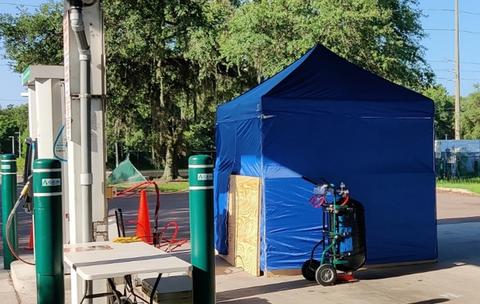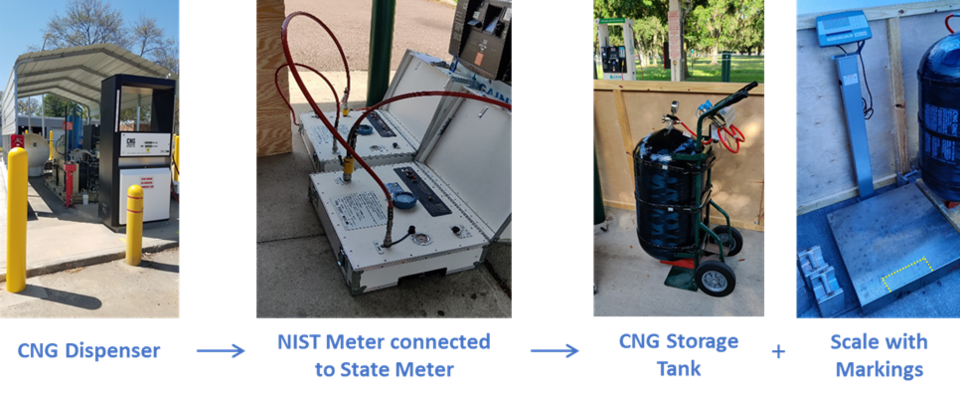Investigating Coriolis Mass Flow Meters as Field Reference Meters – Compressed Natural Gas Applications
Commercial metering systems are ubiquitous in the commercial marketplace (to dispense liquified products, from gas and water to food products and agricultural chemicals). Customers and businesses alike rely on these meters to monitor and deliver their products consistently over time and across a range of locations.
Weights and measures officials use several well-acknowledged field test standards to measure and verify the quantity fuel dispensed and indicated by commercial metering systems. This includes retail motor-fuel dispensers, loading rack meters, and liquefied petroleum gas metering systems. However, many of the traditional field test standards pose both reliability and practical challenges. Thus, NIST Office of Weights and Measures (OWM) has been working with the State weights and measure programs to explore the use of “master meters” or Coriolis mass flow meters as the next generation of field test standards.
For meters dispensing Liquefied Propane Gas (LPG) and other liquid fuels, calibrated volumetric, neck-type provers are most often used as test standards. Compressed Natural Gas (CNG) dispensers and some larger metering systems are typically tested gravimetrically, using a scale and a receiving tank to weigh the dispensed product. What these test standards have in common is that they are much more accurate than the commercial metering system itself. NIST Handbook 44, Appendix A, 3.2 states that when a test standard is used without correction, it shall be three times more accurate than the tolerance applied to the commercial weighing or measuring device.
While volumetric neck-type standards provide a viable way to test a wide range of types and sizes of metering systems, this method can pose challenges for use in certain metering applications. For example, neck-type provers are not suitable for use in testing metering systems dispensing very viscous products due to the difference in drainage properties between those products and the fluid (typically water) used to test the standards in the laboratory. Another example is that of very large metering systems whose high flow rates are such that the capacity of most commercially-available volumetric neck-type standards are not suitable.
While gravimetric testing of commercial measuring systems is an appropriate and recognized method of testing, this test method brings its own set of challenges. Gravimetric test methods can be time consuming and relatively inefficient; may be subject to environmental conditions (e.g., temperature, wind); and often require additional equipment and complex testing procedures. For example, the weighment of dispensed CNG requires an empty tank for the test, and in some cases, the device owner must safely empty the tank between tests or provide the inspector with access to additional empty tanks; something that is not always practical or timely. Often the remaining CNG gas (after weighment) is vented directly into the atmosphere; this is not only a wasteful practice, but it is negative implications for the environment. Some jurisdictions have also raised concerns about safety with regard to some of these practices.
Such hurdles and concerns have urged State and local weights and measure programs to explore mass flow meters as potential field test standards to verify measuring systems. NIST OWM has responded by obtaining a series of seven Coriolis mass flow meters and is collaborating with weights and measures officials and industry to assess their potential use as test standards.
NIST has also established a NIST U.S. National Work Group (USNWG) on Field Reference Meters through which this work is being accomplished. This USNWG provides a forum for the development of uniform and appropriate legal metrology standards that harmonize, where possible, with related national and international standards. As of June 2022, the USNWG includes 51 members representing 11 states and 7 industry organizations in addition to NIST and Measurement Canada. Membership in the USNWG has been inclusive and continues to remain open to any interested party.

The objectives of the USNWG are to:
- investigate the feasibility of using Coriolis-type mass flow meters (indicating in mass, volume, and/or other units) as field test standards in the inspection and testing of commercial liquid/gas measuring systems, including an investigation of and comparisons with current methodologies and standards (e.g., gravimetric testing and neck-type volumetric field test standards and associated test procedures);
- promote, encourage, and participate in the establishment of a comprehensive set of standards, test procedures, and associated methodologies for the use of this type of device as a field test standard;
- develop and document the methodology and process used (including procedures, forms, and other tools) to validate a given design(s) of Coriolis-type mass flow meter for use as a field test standard to enable that methodology and process to be used to validate other designs of Coriolis-type mass flow meters as well as other metering technologies;
- facilitate measurements that establish metrological traceability to the International System of Units (SI) as specified in the current edition of the International Vocabulary of Metrology (VIM); and
- provide recommendations for consideration and use by weights and measures jurisdictions, other work groups, and others interested in this technical work and its application.
This work will include an assessment of whether or not mass flow meters can meet the criteria established in the Fundamental Considerations of NIST Handbook 44 for use as field test standards in testing commercial measuring systems.
For the initial phase of the project the USNWG has undertaken data on testing of CNG dispensers. The USNWG created test protocols and spreadsheets for use in collecting data on the use of mass flow meters for testing CNG measuring systems and will develop similar tools for other applications, including LPG and loading-rack metering systems.
Participating states and their weights and measures staff have included the NIST mass flow meter in the test setup of their CNG dispenser verifications. Some states are already experimenting with use of a mass flow meter for these field tests. In that case, the state’s mass flow meter is also included to provide additional information on different meters.

When using a scale as a standard for testing the dispenser and as a fundamental consideration, the scale must be three times more accurate as the dispenser. Specific to the mass flow meter project, the scale is not only used for testing the dispenser but also for the meter evaluation. Given the goal to demonstrate that mass flow meters can replace the scale as a standard in the inspection of the dispenser, then the mass flow meter must be three times as accurate as the dispenser. For these applications, the scale must be at least nine times more accurate than the dispenser. The dispenser has a tolerance of 1.5 % and therefore the scale must have an accuracy (deviation and uncertainty combined) of 0.15 % of the dispensed amount of CNG.
Preliminary results obtained by the USNWG for CNG demonstrate that the measurements are sensitive to systemic pressure variations. Corrections need to be applied for the various system sections based on the pressure in, and volume of, these sections in order for the mass flow meter to be used as a standard. NIST OWM is currently investigating the exact impact of these corrections. Although the initial results collected this year seem promising, additional fine tuning and testing need to be done to prove the effectiveness of the corrections.
As the next phase in this project, NIST OWM is preparing to begin testing mass flow meters for the verification of LPG dispensers. Although the measurement principles are the same for CNG, the evaluation of LPG measurement systems may require a different operating approach and thus will require input and discussion from the USNWG before finalizing the protocols.
NIST OWM thanks the USNWG members for their continued contribution to this work and especially thanks the participating States who have collected data and have contributed to the USNWG to refine the test protocols.
If you would like additional information or have any questions regarding the NIST OWM Field Reference Meter project activities and/or the working group, please contact Jan Konijnenburg at jan.konijnenburg [at] nist.gov (jan[dot]konijnenburg[at]nist[dot]gov) or Val Miller at val.miller [at] nist.gov (val[dot]miller[at]nist[dot]gov).

